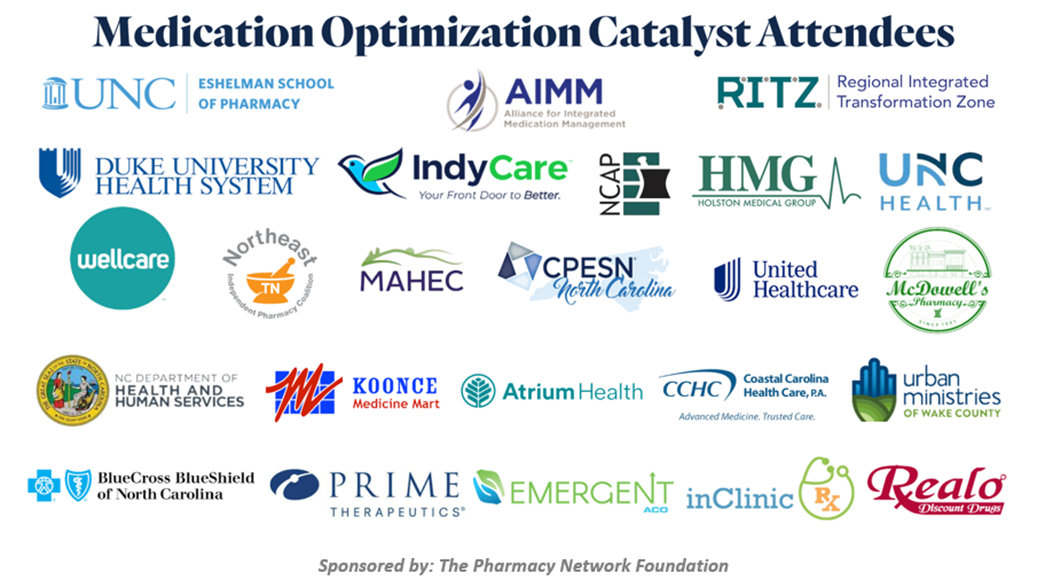On March 8, 2023, the UNC Eshelman School of Pharmacy convened pharmacists, providers, health systems, and payer groups in Chapel Hill, NC to continue discussing priorities, needs, and gaps in population health management in our state. This meeting was in follow-up to the inaugural Medication Optimization Catalyst Event held on November 15, 2022.
The vision of the catalyst event series has been to establish North Carolina as a leading example of state-wide collaboration to expand the reach and adoption of patient care services that optimize medication use and improve health for patients throughout the state.
To achieve this vision, solutions need to be implemented at local community levels. Through this catalyst event series, we sought to build and strengthen community relationships, nurture collaborations, and generate ideas to collectively pursue new population health opportunities. Identifying sustainable models of care to target patients in need, improve patient outcomes, and promote ongoing collaboration between stakeholders was the goal of the day.
The primary outcomes of this Catalyst Event were the identification of exciting possibilities (promising ideas to explore), must haves (critical pieces of the puzzle), and opportunities for action (real, tangible options to develop) for establishing successful collaborative patient care services in NC.
Exciting Possibilities
At the event, medical groups, payers, accountable care organizations (ACOs), and pharmacists came to agreement that we must leverage our existing interdependencies to take care of patients. Promising ideas that should be explored include:
- Partner with community pharmacies to expand reach: Community pharmacists can play a critical role in expanding the reach of health systems, medical centers, ACOs, and payers and increasing patient engagement.
- Focus on measures that matter: Align stakeholder interest around key quality measures for pharmacies, health plans, medical practices, and patients. These measures can be a platform for value-based payment conversations.
- Strengthen partnerships through education: Educating each other on the value each stakeholder brings as well as the pain points of each business model can influence how to partner to improve patient care.
We need to find better ways to establish collaborative agreements between community pharmacies and local medical providers so we can have better, more accurate medication lists, improve medication adherence, and optimize patient outcomes. – Ken Wilkins, CCHC
We need to understand pharmacy clinics better, understand how to read pharmacy claims better. – Mark Gwynne, UNC Health
…the Catalyst Event served as a dialogue starter to understand each entity’s (pharmacy, provider, payer) unique value and pain points of the others. How we develop trust, deliver data, and pay for effort/services that brings enough ROI has yet to be discovered. – Greg Vassie, IndyCare
Must Haves
In order for these exciting possibilities to be turned into successful outcomes, critical pieces must be present or developed.
- Capacity and commitment: each stakeholder must “be in it for the long run.” It takes time to show the impact of scalable partnerships. Thinking outside the box about how things can be done differently may require new resources.
- Relationships: Building partnerships outside of the four walls of your organization requires dedication. Finding the right people to develop the relationships between providers, pharmacists, and payers may take time.
- Data sharing and integration: Communication through technology using an established platform is necessary to take care of the patients stakeholders have in common. This technology should also serve as a mechanism to document value so a framework of payment can be adapted through the partnerships.
When you get to the community level, things move at the speed of trust. – Stephanie Kiser, UNC Eshelman School of Pharmacy; Without relationships, none of this works. – Joe Moose, Moose Pharmacy
Data is another part of this…. I’m really interested in what I can control – generic prescribing and med adherence – with good partners, versus what I can’t control such as medication cost. – Mark Gwynne, UNC Health
Opportunities for Action
Several tangible options to advance population health management through collaborative patient care were shared at the event. Potential next steps for attendees were discussed and are below.
- Advisory board: Create a board of stakeholders to build viable clinically integrated networks to engage partners and determine priorities and essential resources.
- Payer engagement: Utilize payers as connectors and for data sharing support and to identify quality measures that can create a large impact on population health.
- Data Visualization Tools: Create heat maps that identify strengths of the clinically integrated network to address key quality measures and patient care services that bring value to communities and payers.
Our health plan has not routinely included pharmacists in quality meetings or provided pharmacy-specific information to providers on clinical care gap opportunities. We’ve started doing that and it’s been extremely well received. This is the first step in what I hope will be a larger effort to engage providers in discussion on how they can utilize community pharmacists as extenders of their care team. – Christina Nunemacher, WellCare of NC
ACO relationships are key because they are looking at similar things as we are. There are things community pharmacies do that ACOs don’t even know that we are doing. There could be alignment as to why we want to do that. – Thomas McDowell, McDowell’s Pharmacy
We (providers) spend a lot of time trying to improve a specific metric, silo thinking. We meet with a payer, but the outcomes are very different. Hearing the perspectives of others is helpful to strategic thinking. I love hearing what other systems are doing and how other people structure it. The more conversations we have, the more understanding we have. – Mark Gwynne, UNC Health

